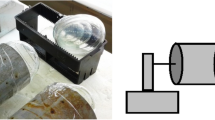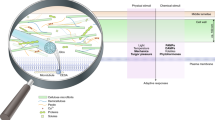Abstract
Plant cells are highly susceptible and receptive to physical factors, both in nature and under experimental conditions. Exposure to mechanical forces dramatically results in morphological and microstructural alterations in their growth. In the present study, cells from chrysanthemum (Dendranthema morifolium) were subjected to constant pressure from an agarose matrix, which surrounded and immobilized the cells to form a cell-gel block. Cells in the mechanically loaded blocks elongated and divided, with an axis preferentially perpendicular to the direction of principal stress vectors. After a sucrose-induced plasmolysis, application of peptides containing an RGD motif, which interferes with plasma membrane-cell wall adhesion, reduced the oriented growth under stress conditions. Moreover, colchicines, but not cytochalasin B, abolished the effects of mechanical stress on cell morphology. Cellulose staining revealed that mechanical force reinforces the architecture of cell walls and application of mechanical force, and RGD peptides caused aggregative staining on the surface of plasmolyzed protoplasts. These results provide evidence that the oriented cell growth in response to compressive stress requires the maintenance of plasmalemma-cell wall adhesion and intact microtubules. Stress-triggered wall development in individual plant cells was also demonstrated.








Similar content being viewed by others
References
Baluska F, Jasik J, Edelmann HG, Salajova T, Volkmann D. 2001. Latrunculin B-induced plant dwarfism: plant cell elongation is F-actin-dependent. Dev Biol 231:113–124
Baluska F, Samaj J, Wojtaszek P, Volkmann D, Menzel D. 2003. Cytoskeleton-plasma membrane-cell wall continuum in plants. Emerging links revisited. Plant Physiol 133:482–491
Baskin TI, Meekes HTHM, Liang BM, Sharp RE. 1999. Regulation of growth anisotropy in well-watered and water-stressed maize roots. II. Role of cortical microtubules and cellulose microfibrils. Plant Physiol 119:681–692
Biddington NL. 1986. The effects of mechanically-induced stress in plants—a review. Plant Growth Regul 4:103–123
Bonn D, Hellay H, Prochnow M, Ben-Djemiaa K, Meunier J. 1998. Delayed fracture of an inhomogeneous soft solid. Science 280:265–267
Braam J. 2005. In touch: plant responses to mechanical stimuli. New Phytologist 165:373–389
Canut H, Carrasco A, Galaud J, Cassan C, Bouyssou H, et al. 1998. High affinity RGD-binding sites at the plasma membrane of Arabidopsis thaliana link the cell wall. Plant J 16:63–71
Chiu JJ, Chen LJ, Chen CN, Lee PL, Lee C. 2004. A model for studying the effect of shear stress on interaction between vascular endothelial cells and smooth muscle cells. J Biomech 37:531–539
Coutand C, Julien JL, Moulia B, Mauget JC, Guitard D. 2000. Biomechanical study of the effect of a controlled bending on tomato stem elongation: global mechanical analysis. J Exp Bot 51:1813–1824
Degenhardt B, Gimmler H. 2000. Cell wall adaptations to multiple environmental stresses in maize roots. J Exp Bot 51:595–603
Geiger B, Bershadsky A. 2001. Assembly and mechanosensory function of focal contacts. Curr Opin Cell Biol 13:584–592
Gertel ET, Green PB. 1977. Cell growth patterns and wall microfibrillar arrangement: experiments with Nitella. Plant Physiol 60:247–254
Giancotti FG, Ruoslahti E. 1999. Integrin signaling. Science 285:1028–1032
Gus-Mayer S, Nation B, Hahlbrock K, Schmelzer E. 1998. Local mechanical stimulation induces components of the pathogen defense response in parsley. Proc Natl Acad Sci USA 95:8398–8403
Hepler PK, Vidali L, Cheng AY. 2001. Polarized cell growth in higher plant. Annu Rev Cell Dev Biol 17:159–187
Holdaway NJ, White RG, Overall RL. 1995. Is the recovery of microtubule orientation in pea roots dependent on the cell wall? Cell Biol Int 19:913–919
Hussey PJ, Allwood EG, Smertenko AP. 2002. Actin-binding protein in the Arabidopsis genome database: properties of functionally distinct plant actin-depolymerizing factors/cofilins. Philos Trans R Soc Lond B 357:791–798
Ingber DE. 2003. Tensegrity. Cell structure and hierarchical systems biology. J Cell Sci 116:157–1173
Jaffe MJ. 1973. Thigmomorphogenesis: the response of plant growth and development to mechanical stimulation. Planta 114:143–157
Jaffe MJ, Forbes S. 1993. Thigmomorphogenesis: the effect of mechanical perturbation on plants. Plant Growth Regul 12:313–324
Kennard JL, Cleary AL. 1997. Pre-mitotic nuclear migration in subsidiary mother cells of Tradescantia occurs in G1 of the cell cycle and requires F-actin. Cell Motil Cytoskel 36:55–67
Komis G, Apostolakos P, Galatis B. 2002. Hyperosmotic stress-induced actin filament reorganization in leaf cells of Chlorophyton comosum. J Exp Bot 53:1699–1710
Lee-Stadelmann OY, Bushnell WR, Stadelmann EJ. 1984. Changes of plasmolysis form in epidermal cells of Hordeum vulgare infected by Erysiphe graminis: evidence for increased membrane-wall adhesion. Can J Bot 62:1714–1723
Lintihac PM, Vesecky TB. 1984. Stress-induced alignment of division plane in plant tissue grown in vitro. Nature 307:363–364
Lloyd CW, Traas JA. 1988. The role of F-actin in determining the division plane of carrot suspension cells. Drug Studies Dev 102:211–221
Lynch TM, Lintilhac PM. 1997. Mechanical signals in plant development: a new method for single cell studies. Dev Biol 181:246–256
Maeda H, Ishida N. 1967. Specificity of binding of hexopyranosyl polysaccharides with fluorescent brightener. J Biochem 62:276–278
Martin C, Bhatt K, Baumann K. 2001. Shaping in plant cells. Curr Opin Plant Biol 4:540–549
Mathur J, Hulskamp M.2002 Microtubules and microfilaments in cell morphogenesis in higher plants. Curr Biol 12:R669–R676
Meijer M, Murray JAH. 2001. Cell cycle controls and the development of plant form. Curr Opin Plant Biol 4:44–49
Mellersh DG, Heath MC. 2001. Plasma membrane-cell wall adhesion is required for expression of plant defense responses during fungal penetration. Plant Cell 13:413–424
Nagata H, Takebe I. 1970. Cell wall regeneration and cell division in isolated tobacco mesophyll protoplasts. Planta 92:301–308
Normand V, Lootens DL, Amici E, Plucknett KP, Aymard P. 2000. New insight into agarose gel mechanical properties. Biomacromolecules 1:730–738
Oparka KJ. 1994. Tansley Review No. 67. Plasmolysis: new insights into an old process. New Phytol 126:571–591
Peters WS, Hagemann W, Tomos AD. 2000. What makes plants different? Principles of extracellular matrix function in “soft” plant tissues. Comp Biochem Physiol A 125:151–167
Reuzeau C, Pont-Lezica R. 1995. Comparing plant and animal extracellular matrix-cytoskeleton connections: are they alike? Protoplasma 186:113–121
Riveline D, Zamir E, Balaban NQ, Schwarz US, Ishizaki T, et al. 2001. Focal contacts as mechanosensors: externally applied local mechanical force induces growth of focal contacts by an mDia1-dependent and ROCK-independent mechanism. J Cell Biol 153:1175–1185
Ruoslahti E., 1996. RGD and other recognition sequences for integrins. Annu Rev Cell Dev Biol 12:697–715
Ruoslahti E, Pierschbacher MD. 1987. New perspective in cell adhesion: RGD and intergrins. Science (Wash DC) 238:491–497
Sato Y, Kadota A, Wada M, 1999. Mechanically induced avoidance response of chloroplasts in fern protonemal cells. Plant Physiol 121:37–44
Schindler M, Meiners S, Cheresh DA. 1989. RGD-dependent linkage between plant cell wall and plasma membrane: consequence for growth. J Cell Biol 108:1955–1965
Trewavas AJ, Knight M. 1994. Mechanical signalling, calcium and plant form. Plant Mol Biol 26:1329–1341
Wang BC, Zhou J, Wang YC. 2006. Physical stress and plant growth. In Floriculture, Ornamental and Plant Biotechnology: Advances and Topical Issues, 1st edition, J. A. Teixeira da Silva, editor, Global Science Books, London, United Kingdom
Wasteneys GO. 2004. Progress in understanding the role of microtubules in plant cells. Current Opin Plant Biol 7:651–660
Wymer CL, Wymer SA, Cosgrove DJ, Cyr RJ. 1996. Plant cell growth responds to external forces and the response requires intact microtubules. Plant Physiol 110:425–430
Zhou J, Wang BC, Li Y, Wang YC. 2006. A system for studying the effect of mechanical stress on the elongation behavior of immobilized plant cells. Colloids Surfaces B Biointerfaces 49:165–174
Acknowledgments
This work was performed with financial support by a fund of National Natural Science Foundation of China (No. 30470431) and the 111 project (No. 1306023). The authors thank Prof. J. J. Chiu for helpful advice and discussion, and Mr. Y. Wang for his encouragement.
Author information
Authors and Affiliations
Corresponding author
Rights and permissions
About this article
Cite this article
Zhou, J., Wang, B., Li, Y. et al. Responses of Chrysanthemum Cells to Mechanical Stimulation Require Intact Microtubules and Plasma Membrane–Cell Wall Adhesion. J Plant Growth Regul 26, 55–68 (2007). https://doi.org/10.1007/s00344-006-0029-2
Received:
Accepted:
Published:
Issue Date:
DOI: https://doi.org/10.1007/s00344-006-0029-2




